Low-Threshold Anti-Stokes Raman Microlaser on Thin-Film Lithium Niobate Chip
Abstract
1. Introduction
2. The Fabrication of the High-Q TFLN Microdisk by the PLACE Technique
3. The Experimental Setup for Low-Threshold SRS and SARS in the Microdisk
4. The Generation of Low-Threshold SRS and SARS Microlasers
5. The Discussion
6. Conclusions
Author Contributions
Funding
Institutional Review Board Statement
Informed Consent Statement
Data Availability Statement
Conflicts of Interest
References
- Kippenberg, T.J.; Spillane, S.M.; Armani, D.K.; Vahala, K.J. Ultralow-threshold microcavity Raman laser on a microelectronic chip. Opt. Lett. 2004, 29, 1224–1226. [Google Scholar] [CrossRef]
- Liu, X.; Sun, C.; Xiong, B.; Wang, L.; Wang, J.; Han, Y.; Hao, Z.; Li, H.; Luo, Y.; Yan, J. Integrated continuous-wave aluminum nitride Raman laser. Optica 2017, 4, 893–896. [Google Scholar] [CrossRef]
- Shen, X.; Choi, H.; Chen, D.; Zhao, W.; Armani, A.M. Raman laser from an optical resonator with a grafted single-molecule monolayer. Nat. Photonics 2020, 14, 95–101. [Google Scholar] [CrossRef]
- Yu, M.; Okawachi, Y.; Cheng, R.; Wang, C.; Zhang, M.; Gaeta, A.L.; Lončar, M. Raman lasing and soliton mode-locking in lithium niobate microresonators. Light Sci. Appl. 2020, 9, 9. [Google Scholar] [CrossRef] [PubMed]
- Zhang, P.-J.; Ji, Q.-X.; Cao, Q.-T.; Wang, H.; Liu, W.; Gong, Q.; Xiao, Y.-F. Single-mode characteristic of a supermode microcavity Raman laser. Proc. Nat. Acad. Sci. USA 2021, 118, e2101605118. [Google Scholar] [CrossRef] [PubMed]
- Özdemir, Ş.K.; Zhu, J.; Yang, X.; Peng, B.; Yilmaz, H.; He, L.; Monifi, F.; Huang, H.S.; Long, G.L.; Yang, L. Highly sensitive detection of nanoparticles with a self-referenced and self-heterodyned whispering-gallery Raman microlaser. Proc. Nat. Acad. Sci. USA 2014, 111, E3836–E3844. [Google Scholar] [CrossRef] [PubMed]
- Lin, G.; Chembo, Y.K. Phase-locking transition in Raman coms generated with whispering gallery mode resonators. Opt. Lett. 2016, 41, 3718–3721. [Google Scholar] [CrossRef] [PubMed]
- Chiasera, A.; Dumeige, Y.; Feron, P.; Ferrari, M.; Jestin, Y.; Conti, G.N.; Pelli, S.; Soria, S.; Righini, G.C. Spherical whispering-gallery-mode microresonators. Laser Photonics Rev. 2010, 4, 457–482. [Google Scholar] [CrossRef]
- Choi, H.; Chen, D.; Du, F.; Zeto, R.; Armani, A. Low threshold anti-Stokes Raman laser on-chip. Photonics Res. 2019, 7, 926–932. [Google Scholar] [CrossRef]
- Spillane, S.; Kippenberg, T.; Vahala, K. Ultralow-threshold Raman laser using a spherical dielectric microcavity. Nature 2002, 415, 621–623. [Google Scholar] [CrossRef]
- Ferrara, M.A.; Sirleto, L. Integrated Raman laser: A review of the last two decades. Micromachines 2020, 11, 330. [Google Scholar] [CrossRef]
- Lu, T.; Yang, L.; Carmon, T.; Min, B. A narrow-linewidth on-chip toroid Raman laser. IEEE J. Quant. Electron. 2011, 47, 320–326. [Google Scholar] [CrossRef]
- Itzkan, I.; Leonard, D.A. Observation of coherent anti-Stokes Raman scattering from liquid water. Appl. Phys. Lett. 1975, 26, 106–108. [Google Scholar] [CrossRef]
- Hudson, B.; Hetherington, W.; Cramer, S.; Chabay, I.; Klauminzer, G.K. Resonance enhanced coherent anti-Stokes Raman scattering. Proc. Nat. Acad. Sci. USA 1976, 73, 3798–3802. [Google Scholar] [CrossRef] [PubMed]
- Barrett, J.J.; Begley, R.F. Low-power cw generation of coherent anti-Stokes Raman radiation in CH4 gas. Appl. Phys. Lett. 1975, 27, 129–131. [Google Scholar] [CrossRef]
- Rittner, K.; Hope, A.; Muller-Wirts, T.; Wellegehausen, B. Continuous anti-Stokes Raman lasers in a He-Ne laser discharge. IEEE J. Quantum Electron. 1992, 28, 342–347. [Google Scholar] [CrossRef]
- Lin, J.; Bo, F.; Cheng, Y.; Xu, J. Advances in on-chip photonic devices based on lithium niobate on insulator. Photonics Res. 2020, 8, 1910–1936. [Google Scholar] [CrossRef]
- Kang, H.; Lee, D.; Yang, Y.; Oh, D.K.; Seong, J.; Kim, J.; Jeon, N.; Kang, D.; Rho, J. Emerging low-cost, large-scale photonic platforms with soft lithography and self-assembly. Photonics Insights 2023, 2, R04. [Google Scholar] [CrossRef]
- Chen, G.; Li, N.; Ng, J.D.; Lin, H.-L.; Zhou, Y.; Fu, Y.H.; Lee, L.Y.T.; Yu, Y.; Liu, A.-Q.; Danner, A.J. Advances in lithium niobate photonics: Development status and perspectives. Advanced Photonics 2022, 4, 034003. [Google Scholar] [CrossRef]
- Luo, Q.; Bo, F.; Kong, Y.; Zhang, G.; Xu, J. Advances in lithium niobate thin-film lasers and amplifiers: A review. Adv. Photon. 2023, 5, 034002. [Google Scholar] [CrossRef]
- Lin, J.; Farajollahi, S.; Fang, Z.; Yao, N.; Gao, R.; Guan, J.; Deng, L.; Lu, T.; Wang, M.; Zhang, H. Electro-optic tuning of a single-frequency ultranarrow linewidth microdisk laser. Adv. Photon. 2022, 4, 036001. [Google Scholar] [CrossRef]
- Zheng, Y.; Chen, X. Nonlinear wave mixing in lithium niobate thin film. Adv. Phys. X 2021, 6, 1889402. [Google Scholar] [CrossRef]
- Lin, J.; Yao, N.; Hao, Z.; Zhang, J.; Mao, W.; Wang, M.; Chu, W.; Wu, R.; Fang, Z.; Qiao, L.; et al. Broadband quasi-phase-matched harmonic generation in an on-chip monocrystalline lithium niobate microdisk resonator. Phys. Rev. Lett. 2019, 122, 173903. [Google Scholar] [CrossRef] [PubMed]
- Jia, Y.; Wang, L.; Chen, F. Ion-cut lithium niobate on insulator technology: Recent advances and perspectives. Appl. Phys. Rev. 2021, 8, 011307. [Google Scholar] [CrossRef]
- Gao, R.; Fu, B.; Yao, N.; Guan, J.; Zhang, H.; Lin, J.; Li, C.; Wang, M.; Qiao, L.; Cheng, Y. Electro-optically tunable low phase-noise microwave synthesizer in an active lithium niobate microdisk. Laser Photon. Rev. 2023, 17, 2200903. [Google Scholar] [CrossRef]
- Zhu, D.; Shao, L.; Yu, M.; Cheng, R.; Desiatov, B.; Xin, C.; Hu, Y.; Holzgrafe, J.; Ghosh, S.; Shams-Ansari, A. Integrated photonics on thin-film lithium niobate. Adv. Opt. Photon. 2021, 13, 242–352. [Google Scholar] [CrossRef]
- Li, M.; Ling, J.; He, Y.; Javid, U.A.; Xue, S.; Lin, Q. Lithium niobate photonic-crystal electro-optic modulator. Nat. Commun. 2020, 11, 4123. [Google Scholar] [CrossRef] [PubMed]
- Lu, J.; Li, M.; Zou, C.L.; Sayem, A.A.; Tang, H.X. Toward 1% single-photon anharmonicity with periodically poled lithium niobate microring resonators. Optica 2020, 7, 1654–1659. [Google Scholar] [CrossRef]
- Xue, G.-T.; Niu, Y.-F.; Liu, X.; Duan, J.-C.; Chen, W.; Pan, Y.; Jia, K.; Wang, X.; Liu, H.-Y.; Zhang, Y.; et al. Ultrabright multiplexed energy-time-entangled photon generation from lithium niobate on insulator chip. Phys. Rev. Appl. 2021, 15, 064059. [Google Scholar] [CrossRef]
- Stokowski, H.S.; McKenna, T.P.; Park, T.; Hwang, A.Y.; Dean, D.J.; Celik, O.T.; Ansari, V.; Fejer, M.M.; Safavi-Naeini, A.H. Integrated quantum optical phase sensor in thin film lithium niobate. Nat. Commun. 2023, 14, 3355. [Google Scholar] [CrossRef]
- Ma, Z.; Chen, J.Y.; Li, Z.; Tang, C.; Sua, Y.M.; Fan, H.; Huang, Y.-P. Ultrabright quantum photon sources on chip. Phys. Rev. Lett. 2020, 125, 263602. [Google Scholar] [CrossRef]
- Zhang, K.; Sun, W.; Chen, Y.; Feng, H.; Zhang, Y.; Chen, Z.; Wang, C. A power-efficient integrated lithium niobate electro-optic comb generator. Commun. Phys. 2023, 6, 17. [Google Scholar] [CrossRef]
- Rao, A.; Fathpour, S. Compact lithium niobate electrooptic modulators. IEEE J. Sel. Top. Quantum Electron. 2017, 24, 1–14. [Google Scholar] [CrossRef]
- Amiune, N.; Puzyrev, D.N.; Pankratov, V.V.; Skryabin, D.V.; Buse, K.; Breunig, I. Optical-parametric-oscillation-based χ(2) frequency comb in a lithium niobate microresonator. Opt. Express 2021, 29, 41378–41387. [Google Scholar] [CrossRef]
- Luo, R.; He, Y.; Liang, H.; Li, M.; Lin, Q. Highly tunable efficient second-harmonic generation in a lithium niobate nanophotonic waveguide. Optica 2018, 5, 1006–1011. [Google Scholar] [CrossRef]
- Zhang, M.; Wang, C.; Kharel, P.; Zhu, D.; Lončar, M. Integrated lithium niobate electro-optic modulators: When performance meets scalability. Optica 2021, 8, 652–667. [Google Scholar] [CrossRef]
- Wu, R.; Zhang, J.; Yao, N.; Fang, W.; Qiao, L.; Chai, Z.; Lin, J.; Cheng, Y. Lithium niobate micro-disk resonators of quality factors above 107. Opt. Lett. 2018, 43, 4116–4119. [Google Scholar] [CrossRef] [PubMed]
- Zhao, Y.; Liu, X.; Yvind, K.; Cai, X.; Pu, M. Widely-tunable, multi-band Raman laser based on dispersion-managed thin-film lithium niobate microring resonators. Commun. Phys. 2023, 6, 350. [Google Scholar] [CrossRef]
- Zhao, G.; Lin, J.; Fu, B.; Gao, R.; Li, C.; Yao, N.; Guan, J.; Li, M.; Wang, M.; Qiao, L. Integrated multi-color Raman microlasers with ultra-low pump levels in single high-Q lithium niobate microdisks. arXiv 2023, arXiv:2312.10347. [Google Scholar]
- Sidorov, N.V.; Kruk, A.A.; Yanichev, A.A.; Palatnikov, M.N.; Mavrin, B.N. Temperature investigations of Raman spectra of stoichiometric and congruent lithium niobate crystals. Opt. Spectrosc. 2014, 117, 560–571. [Google Scholar] [CrossRef]
- Simons, M.T.; Novikova, I. Observation of second-order hyper-Raman generation in LiNbO3 whispering-gallery mode disk resonators. Opt. Lett. 2011, 36, 3027–3029. [Google Scholar] [CrossRef] [PubMed]
- Moore, J.; Tomes, M.; Carmon, T.; Jarrahi, M. Continuous-wave cascaded-harmonic generation and multi-photon Raman lasing in lithium niobate whispering-gallery resonators. Appl. Phys. Lett. 2011, 99, 221111. [Google Scholar] [CrossRef]
- Gao, R.; Zhang, H.; Bo, F.; Fang, W.; Hao, Z.; Yao, N.; Lin, J.; Guan, J.; Deng, L.; Wang, M.; et al. Broadband highly efficient nonlinear optical processes in on-chip integrated lithium niobate microdisk resonators of Q-factor above 108. New J. Phys. 2021, 23, 123027. [Google Scholar] [CrossRef]
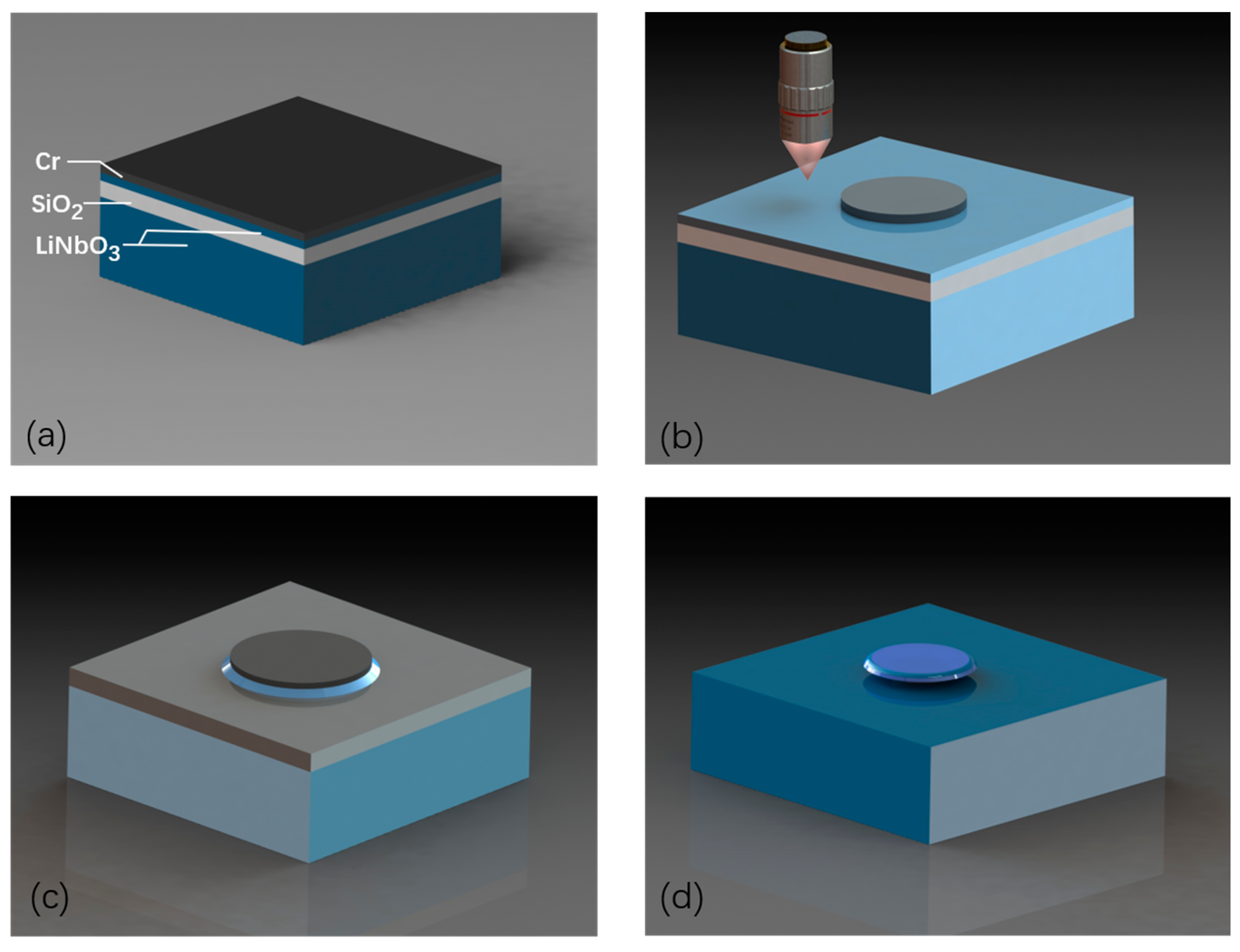
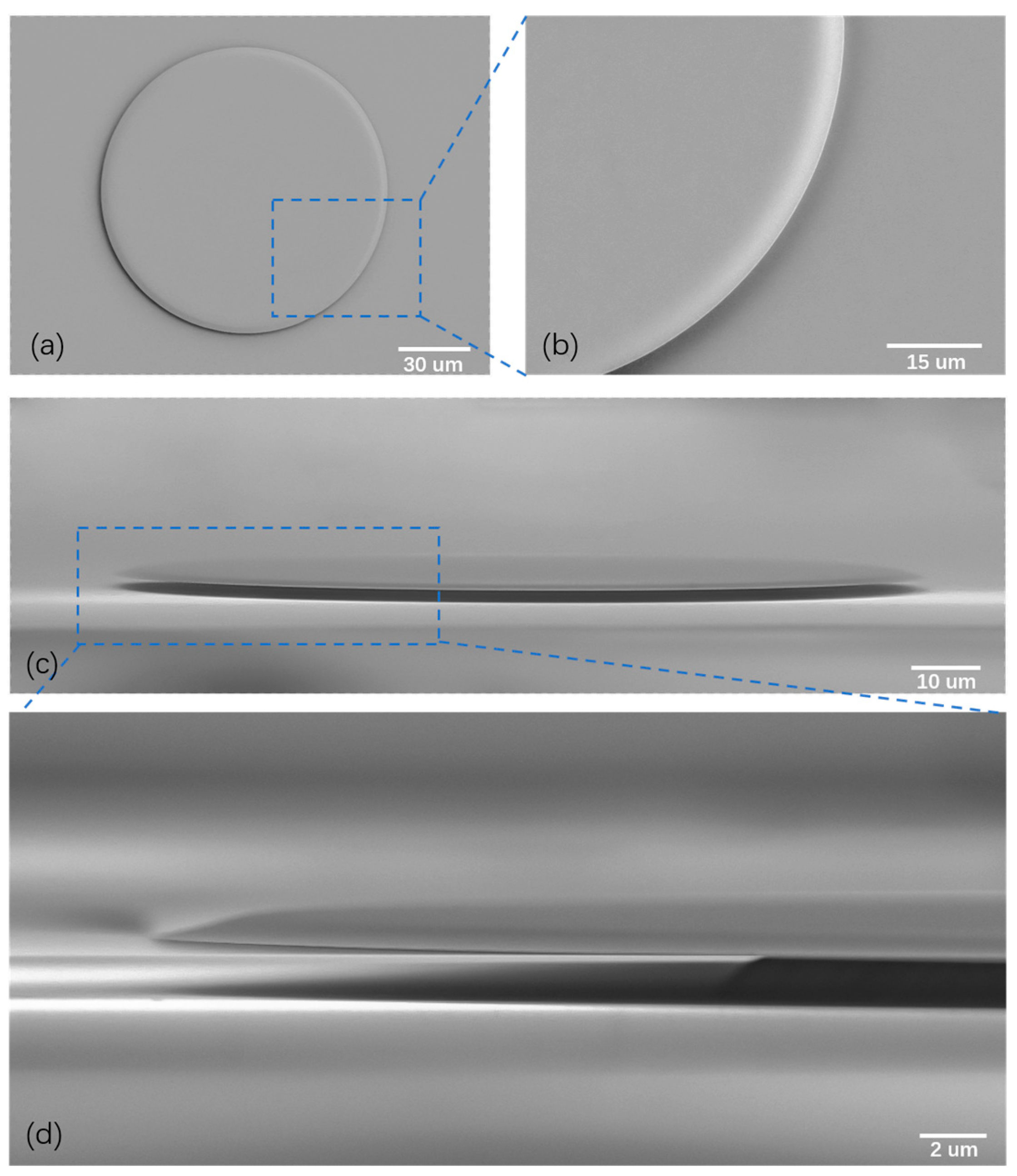
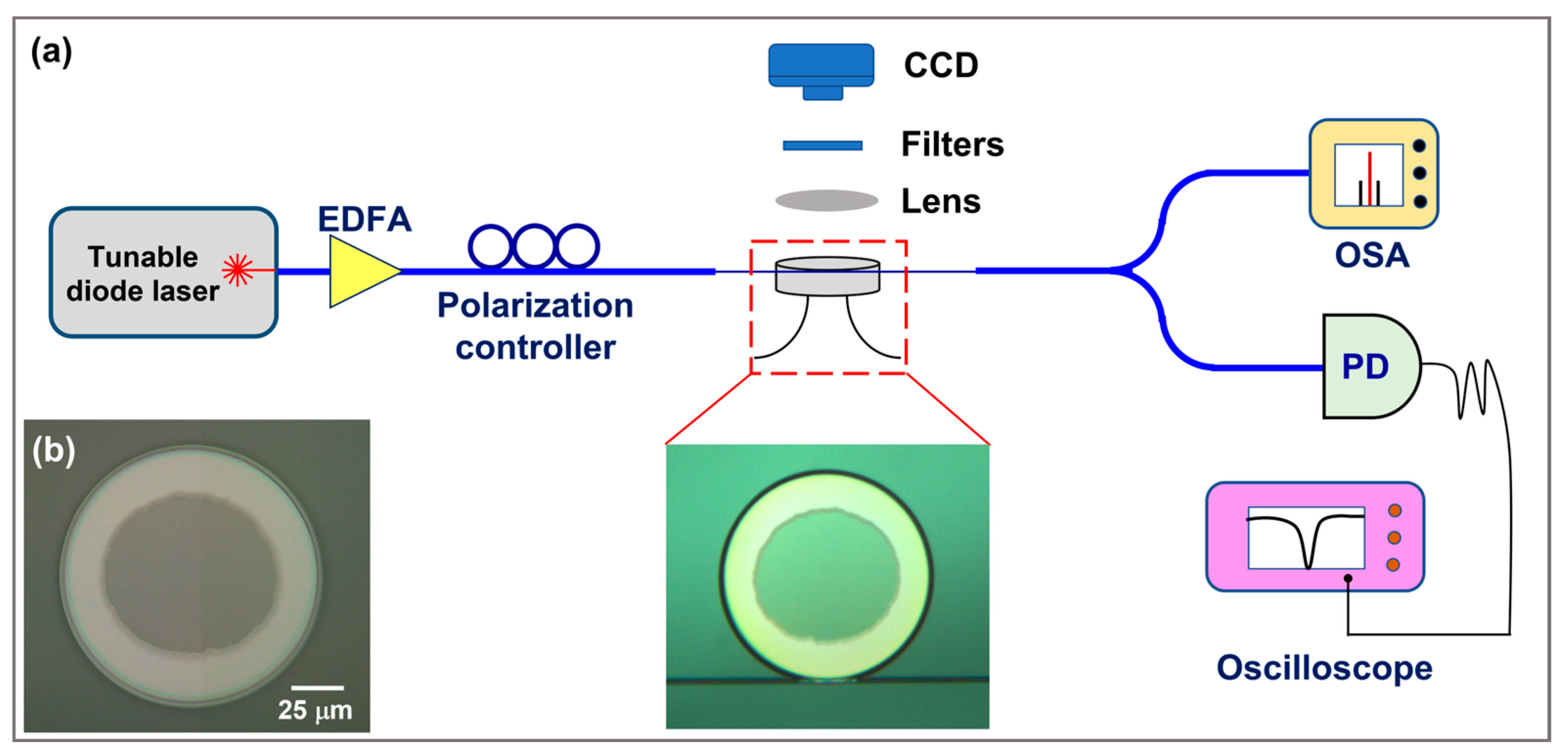
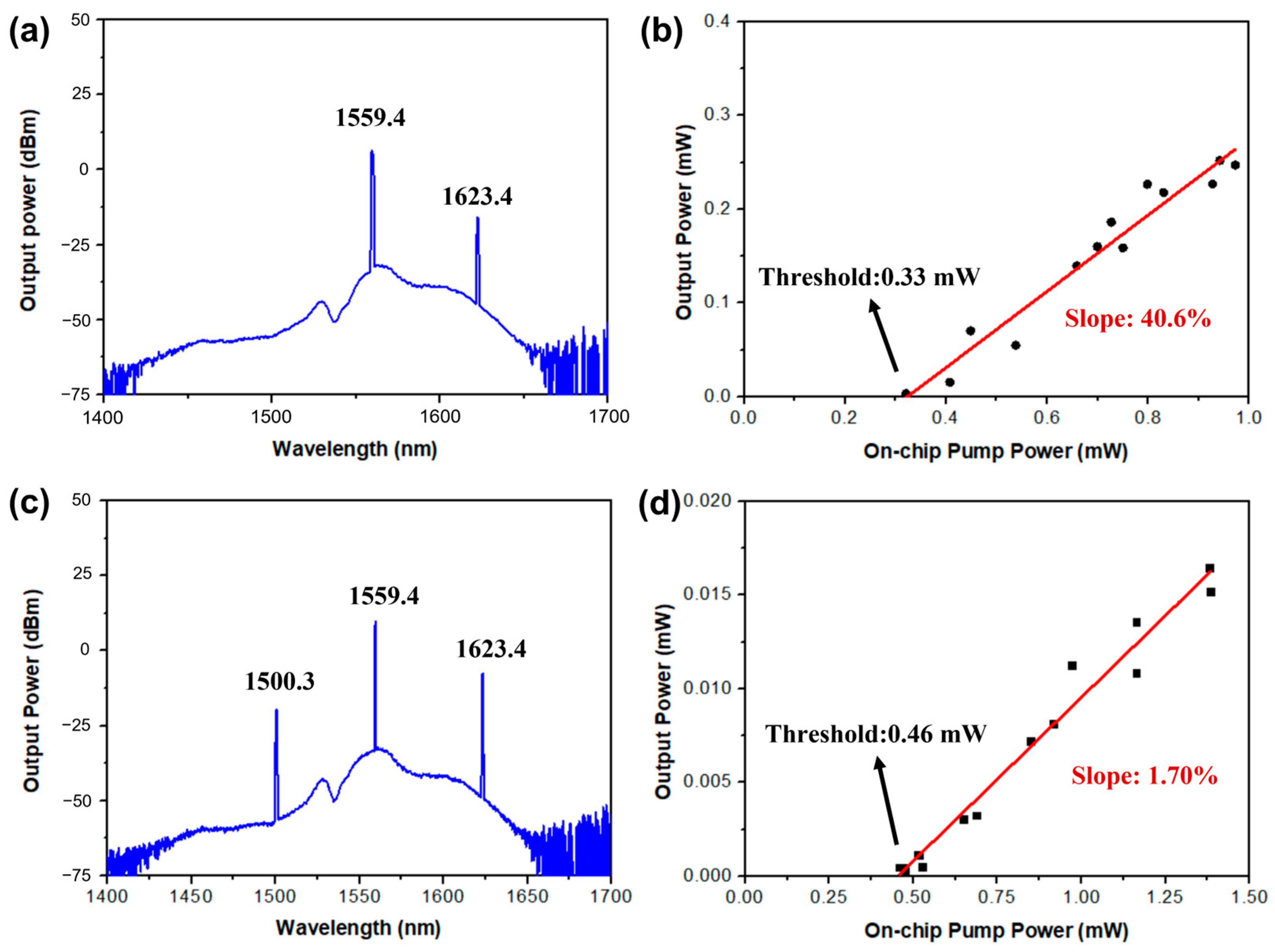
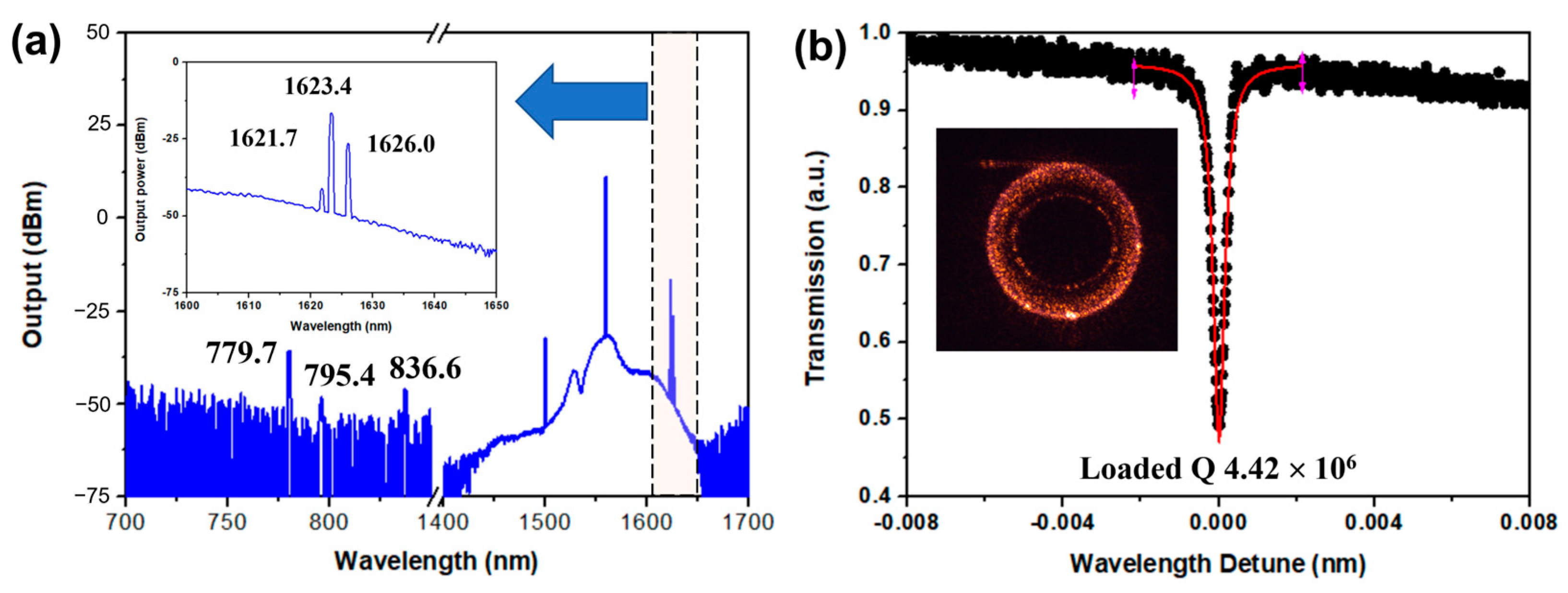
Disclaimer/Publisher’s Note: The statements, opinions and data contained in all publications are solely those of the individual author(s) and contributor(s) and not of MDPI and/or the editor(s). MDPI and/or the editor(s) disclaim responsibility for any injury to people or property resulting from any ideas, methods, instructions or products referred to in the content. |
© 2024 by the authors. Licensee MDPI, Basel, Switzerland. This article is an open access article distributed under the terms and conditions of the Creative Commons Attribution (CC BY) license (https://creativecommons.org/licenses/by/4.0/).
Share and Cite
Guan, J.; Lin, J.; Gao, R.; Li, C.; Zhao, G.; Li, M.; Wang, M.; Qiao, L.; Cheng, Y. Low-Threshold Anti-Stokes Raman Microlaser on Thin-Film Lithium Niobate Chip. Materials 2024, 17, 1042. https://doi.org/10.3390/ma17051042
Guan J, Lin J, Gao R, Li C, Zhao G, Li M, Wang M, Qiao L, Cheng Y. Low-Threshold Anti-Stokes Raman Microlaser on Thin-Film Lithium Niobate Chip. Materials. 2024; 17(5):1042. https://doi.org/10.3390/ma17051042
Chicago/Turabian StyleGuan, Jianglin, Jintian Lin, Renhong Gao, Chuntao Li, Guanghui Zhao, Minghui Li, Min Wang, Lingling Qiao, and Ya Cheng. 2024. "Low-Threshold Anti-Stokes Raman Microlaser on Thin-Film Lithium Niobate Chip" Materials 17, no. 5: 1042. https://doi.org/10.3390/ma17051042
APA StyleGuan, J., Lin, J., Gao, R., Li, C., Zhao, G., Li, M., Wang, M., Qiao, L., & Cheng, Y. (2024). Low-Threshold Anti-Stokes Raman Microlaser on Thin-Film Lithium Niobate Chip. Materials, 17(5), 1042. https://doi.org/10.3390/ma17051042







